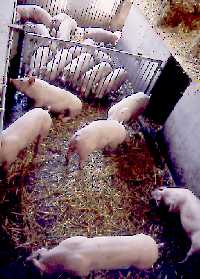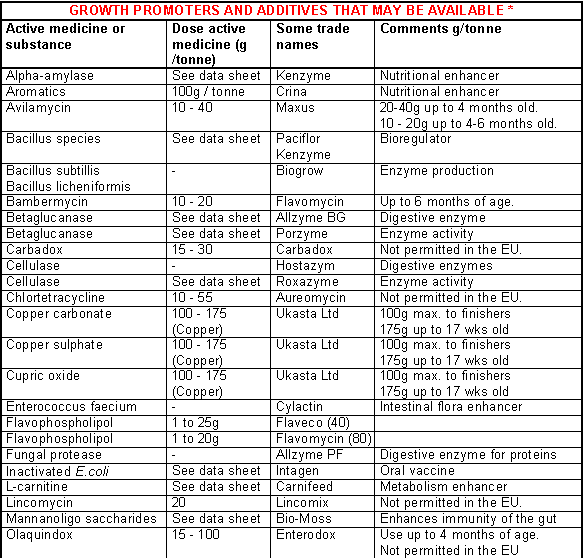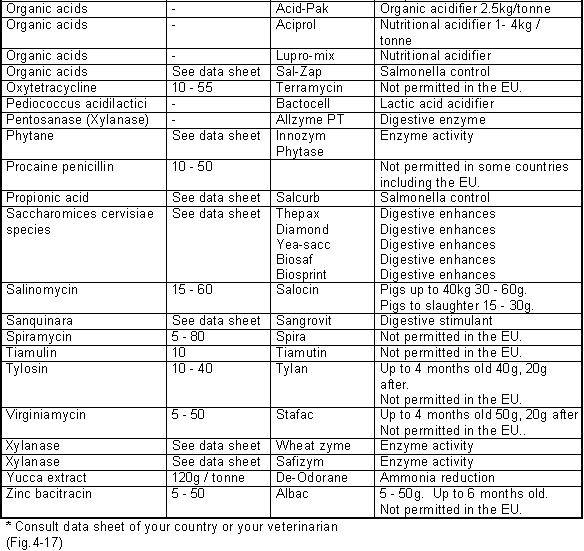



Growth promoters

The aim of efficient pig production is to maximise growth. This can be aided by the inclusion of specific growth promoting substances to the feed. It is worth remembering that growth is also maximised by:
- The correct levels of vitamins in the diet.
- The correct levels of minerals, protein and energy.
- Metallic compounds such as copper.
- Some sedatives.
- Anabolic steroids.
- The effects of management, the environment, disease, genetics and housing.
How the farm is managed has most important effects on growth promotion. Such factors include, health status and the presence of specific diseases, pig flow and all in all out production, the streaming of the pigs, general hygiene and the control of the environment. The effects of disease and as a result reduction in feed intake and Immunosuppression markedly affect growth.
The inclusion of anti microbial substances in the feed is the most common and cost effective method of promoting growth. Such growth promoters at very low levels have the effect of reducing the activity of the organisms in the gut which increases the efficiency of the absorption of food from the intestine and suppresses any harmful products of bacterial metabolism.
How cost effective are growth promoters.?
A summary of data over the past 15 years shows the following:
- Improvements in average daily gain of up to 4 %.
- Improvements in average daily feed intake by 0.2 - 1.4 %.
- Improvements in food conversion rate by 2.5 - 3.9 %.
However the more healthy the herd and the fewer the diseases, the less will be the effect.
In assessing whether to use a growth promoter consider the following:
- Ask to see all the trial data across a wide range of farm conditions.
- Ensure that the results are statistically significant.
- Seek veterinary advice as to the suitability of the product for your farm. For example, if you have a high health herd the effects may be minimal. Conversely the substance may assist in controlling a problem such as ileitis.
- Ask your feed supplier for his experiences and cost effectiveness and comments from other farmers using it.
- Beware of unsubstantiated claims.
The question is often asked "Are these substances harmful to the health of either animals or man?". To date there is no evidence to suggest they have any adverse effect whatsoever.
Licensed growth promoters usually have a nil withdrawal period, and most are antibiotics that have little or no therapeutic action in the pig and are not used in human medicine. There are a few exceptions to this, for example tylosin (Tylan).
The characteristics required for a growth promoter:
They must not be absorbed from the intestines or found in the edible tissues.
They must be non toxic to both animals and people.
Performance must be improved with economic benefit.
There must be no adverse effects in relation to other antibiotics.
They must have no therapeutic value in human medicine.
They must not alter the normal bacteria in the gut, or allow one organism to predominate over another, for example salmonella.
They must not pollute the environment and must be quickly biodegradable.
They must not increase medicine resistance or be
involved in the transfer of medicine resistance between one bacterial species
and another.
However tylosin (Tylan), spiramycin, zinc bacitracin, virginiamycin, carbadox and olaquindox are now banned in the EU (01-08-99) for growth promoter purposes. A variety of substances are shown in Fig.4-17. They can be classified as follows.
Types of Growth Promoting Agents Available
Antimicrobial Growth Promoters (antibiotics)
They include Avilamycin, Carbadox, Flavomycin, Olaquindox, Spiramycin, Salinomycin, Tylosin (Tylan), Virginiamycin and Zinc bacitracin. At this time in the EU only Avilamycin and Salinomycin are now approved.
Acidic Growth Promoters
These act by either lowering the pH of the intestinal contents and or they have an antibacterial effect.
The former include acids such as Lactic, Citric fumaric and Malic acids. Those having antibacterial effect include Acetic propionic, and Formic acids.
Mineral Clays
These are substances that have the ability to absorb toxins from the digestive systems which may allow pathogenic bacteria to proliferate. Attapulgite would be a typical example. Their value has not been established.
Enzymes
These are many and varied and found in the digestive system of all mammals. Pigs have difficulty in breaking down the complex cell structures particularly in wheat. Enzymes assist in the breakdown of fibre and also enhance the efficiency of digestion of vegetable proteins, peas, beans and soya beans.
Each enzyme is specific in its action.
The digestion of dietary fibre is enhanced by carbohydrates such as beta glucanase or Xylanase which act upon fibres such as arabinoxylans and beta-glucans. Such fibres contain anti nutritional factors, that are also found in proteins. New enzymes have appeared on the market (proteases) to assist in the breakdown of such proteins and results have shown reductions in digestive disturbances particularly in weaned pigs.
Fermentation
| Feed Additives | Efficiency |
| Antibiotics |
+++++ |
| Copper sulphate |
+++ |
| Enzymes |
+++ |
| Fermentation |
? |
| Immunoglobulins |
++ |
| Lactose |
++ |
| Mineral clays |
? |
| Organic acids |
+ |
| Probiotics |
+ |
| Probiotics (fermentation) |
++ |
| Zinc oxide |
++++ |
+++++ Most
efficient |
|
Liquid diets provide the opportunity to create acid conditions by fermentation through the inclusion of certain micro organisms such as lactobacillus species prior to feeding. The establishment of the latter in the intestine, particularly in the weaned pig, helps to prevent the establishment of pathogenic bacteria. Fermentation also increases the digestibility of the diet with increased efficiency of use.
Metallic Substances
The use of copper as a growth promoter is well documented. Zinc oxide has proved to be very efficient in preventing post weaning diarrhoea at levels of 250ppm of elemental zinc.
Nutraceuticals
These are substances originating from different plants and whilst many claims are made for their effectiveness they are yet to be substantiated with confidence. Fatty acids and plants with high levels of vitamin E claim to increase the efficiency of the immune system. Claims are also made for garlic, ginseng, oregano and extract of cinnamon, aniseed, rosemary, peppermint and propolis extracted from honey.
Probiotics
These are living cultures of bacteria such as lactobacillus, bacillus species and yeasts, that are added to the diet. The exact way in which they promote growth is unclear and their efficiency appears to be most effective in the young growing pig.
A subjective guide* as to the efficiency of feed additives for promoting growth is shown. *(The Meat and Livestock Commission - UK)


Further reading
About Antibiotics: Types, Uses and Food Safety Considerations
Alternatives to antibiotics as growth promoters
A list of articles highlighting the concerns over the use of farm antibiotics as growth promoters.





